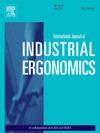Experimental study on a novel phase change cooling garment to improve the thermal comfort of live-line workers
IF 3
2区 工程技术
Q2 ENGINEERING, INDUSTRIAL
International Journal of Industrial Ergonomics
Pub Date : 2025-06-13
DOI:10.1016/j.ergon.2025.103774
引用次数: 0
Abstract
The study investigated the impact of a phase change cooling garment on the thermal comfort of live-line workers in humid and hot environments (38 °C, 75 % RH). A novel phase change cooling garment (C1), weighing 3.21 kg, was developed based on ergonomic design. The cooling effectiveness of C1 was assessed through evaluations conducted in an artificial climate chamber and field experiments. These evaluations measured physiological parameters such as heart rate, blood pressure, blood oxygen saturation, skin temperature, and core temperature, along with subjective questionnaires that covered overall and local thermal sensation, thermal comfort, and moisture sensation. The results demonstrated that C1 effectively reduced both the average and local skin temperatures in the cooled areas. Specifically, the average skin temperature decreased by approximately 2.4 °C, head skin temperature by about 1.2 °C, torso skin temperature by about 5.7 °C, and neck skin temperature by about 5.9 °C. Core temperature showed a reduction of approximately 0.4 °C. The use of C1 had minimal impact on other physiological parameters measured. Additionally, C1 significantly lowered subjective thermal sensation scores, with the overall thermal sensation vote (TSV) decreasing by 2.65 levels and the overall thermal comfort vote (TCV) decreasing by 1.7 levels. The overall heat stress level was reduced from severe to mild. Compared to other cooling garments, C1 exhibited superior performance in terms of thermal comfort. The findings provide valuable guidance for the design of personal phase change cooling garments, contributing to enhanced safety and comfort for live-line workers in humid and hot environments.
提高现场工作人员热舒适性的新型相变冷却服的实验研究
该研究调查了相变冷却服对湿热环境(38°C, 75%相对湿度)下现场工作人员热舒适性的影响。基于人体工学设计,研制了一种重3.21 kg的新型相变冷却服(C1)。通过人工气候室和现场实验对C1的降温效果进行了评价。这些评估测量了生理参数,如心率、血压、血氧饱和度、皮肤温度和核心温度,以及涵盖整体和局部热感觉、热舒适和水分感觉的主观问卷。结果表明,C1有效降低了冷区平均皮肤温度和局部皮肤温度。具体而言,平均皮肤温度下降约2.4°C,头部皮肤温度下降约1.2°C,躯干皮肤温度下降约5.7°C,颈部皮肤温度下降约5.9°C。岩心温度降低了约0.4℃。使用C1对测量的其他生理参数影响最小。此外,C1显著降低了主观热感觉评分,总热感觉投票(TSV)降低了2.65个等级,总热舒适投票(TCV)降低了1.7个等级。整体热应激水平由重度降至轻度。与其他制冷服装相比,C1在热舒适性方面表现出优越的性能。研究结果为个人相变冷却服的设计提供了有价值的指导,有助于提高湿热环境下现场工作人员的安全性和舒适性。
本文章由计算机程序翻译,如有差异,请以英文原文为准。
求助全文
约1分钟内获得全文
求助全文
来源期刊
CiteScore
6.40
自引率
12.90%
发文量
110
审稿时长
56 days
期刊介绍:
The journal publishes original contributions that add to our understanding of the role of humans in today systems and the interactions thereof with various system components. The journal typically covers the following areas: industrial and occupational ergonomics, design of systems, tools and equipment, human performance measurement and modeling, human productivity, humans in technologically complex systems, and safety. The focus of the articles includes basic theoretical advances, applications, case studies, new methodologies and procedures; and empirical studies.

 求助内容:
求助内容: 应助结果提醒方式:
应助结果提醒方式:


